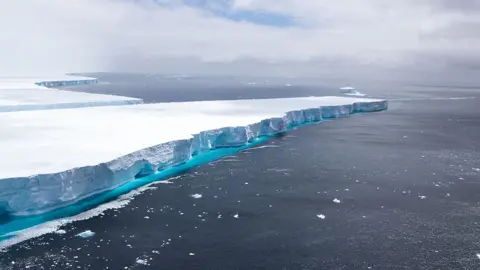World’s Largest Iceberg Breaks Away, Exposing a Long-Lost Structure
Icebergs may seem like massive blocks of ice floating in the ocean, but there’s much more happening beneath the surface. Something incredible recently occurred: the largest iceberg ever recorded split off, revealing a structure hidden for centuries. From the colossal Iceberg B15, roughly the size of Jamaica, to icebergs holding mysterious cabins within their bedrock, scientists and explorers are thrilled. Let’s explore these remarkable events.
**1. Iceberg B15 – Nature’s Giant Showpiece**

In March 2000, Iceberg B15 drastically separated from Antarctica’s Ross Ice Shelf near Roosevelt Island. This was no ordinary iceberg; it measured 295 km long and 37 km wide—comparable to Jamaica. The calving followed natural cracks in the ice shelf, a phenomenon occurring every 50 to 100 years. After breaking free, B15 gradually fractured into smaller pieces. Its largest chunk, B15A, remains enormous at 120 km long, covering an area larger than Luxembourg.
In April 2005, B15A collided with the Drygalski Ice Tongue, breaking off two 70 sq. km chunks. By 2006, it fragmented further, with pieces like B15Z catching the attention of astronauts aboard the International Space Station. By 2018, these remnants were breaking apart, signaling the iceberg’s end. Throughout its journey, satellites closely monitored B15, offering scientists valuable insights into iceberg dynamics.
**2. Ward Hunt Ice Shelf – A 3,000-Year Legacy**

The Ward Hunt Ice Shelf on Canada’s Ellesmere Island stood strong for over 3,000 years, but by the early 2000s, it began to fracture. In 2002, satellite images revealed significant cracks that evolved into major breaks, releasing large ice islands. By 2008, the shelf fragmented into three main pieces, akin to a live-action breakup on a geological scale. Researchers like Dr. Derek Mueller studied these changes, revealing a network of cracks and the loss of a rare freshwater ecosystem once damaged by the shelf.
**3. Amery Ice Shelf – London-Sized Drama**

In September 2019, the Amery Ice Shelf calved a massive iceberg, D28, comparable in size to London. Measuring 1,636 sq. km, this natural event was long anticipated by scientists monitoring the shelf’s cracks. Despite its dramatic nature, the calving wasn’t linked to climate change but was part of the ice shelf’s natural cycle. NASA’s ICESat-2 and MODIS instruments provided detailed observations, helping researchers understand these events and their impacts on sea levels.
**4. Helheim Glacier – Capturing a Glacier’s Escape**

In June 2018, Greenland’s Helheim Glacier released a colossal iceberg roughly 6.4 km long—half the size of Manhattan. Researchers, including Professor David Holland, recorded the event in a stunning 90-second video. Understanding these calving events helps refine models predict glaciers’ contributions to rising sea levels. Helheim Glacier has since retreated inland, reflecting the wider impacts of climate change.
**5. A Perfect Rectangle – NASA’s Iceberg Discovery**

During an Operation IceBridge flight in October 2018, NASA scientist Jeremy Harbeck spotted a nearly perfect rectangular iceberg near Antarctica’s Larsen C Ice Shelf. Standing 130 ft tall and stretching a mile long, this tabular iceberg likely calved from Larsen C, known for its dramatic ice break-offs. The discovery underscores the dynamic nature of ice shelves and their role in climate systems.
**6. Iceberg A68 – A Giant’s Journey**

In July 2017, Iceberg A68, twice the size of Luxembourg, calved from Larsen C, reducing the shelf’s size by 12%. This massive iceberg reveals seabed hidden areas for millennia. A68 later fragmented as it drifted across the Weddell Sea, with its largest piece, A68A, reaching South Georgia by December 2020. Concerns arose about its impact on local wildlife, but by 2021, A68 had broken into smaller fragments and melted away.
**7. Iceberg B22 – The Doomsday Glacier’s Offspring**

In March 2002, Thwaites Glacier calved Iceberg B22, a massive 85 km-long and 64 km-wide chunk. The iceberg later broke into smaller pieces, with the largest fragment, B22A, grounding itself in the Amundsen Sea. After two decades of inactivity, B22A began drifting again in late 2022, highlighting the unpredictable nature of these icy giants.
**8. Chasm 1 – A New Break on the Brunt Ice Shelf**
In 2023, cracks on Antarctica’s Brunt Ice Shelf, including Chasm 1, caused a significant calving event. Scientists closely monitored the activity to ensure the safety of research stations nearby. These calving events demonstrate the dynamic balance of growth and decay in ice shelves, with dramatic impacts on polar ecosystems.
9. Milne Ice Shelf – A 4,000-Year-Old Legacy Shattered

In July 2020, Canada’s Milne Ice Shelf lost 43% of its mass, forming a massive ice island. This ancient shelf, considered stable due to its thickness, succumbed to record-high temperatures and melt ponds that weakened its structure. Its collapse serves as a stark reminder of the vulnerability of even the most resilient ice shelves in a warming climate.
**Internal Sabotage**
What’s particularly heartbreaking is the ecological thriller that unfolded with the collapse of the Milne Ice Shelf. This was not just a massive block of ice; it served as a natural dam, holding back meltwater and forming a rare epishelf lake—a fascinating habitat where freshwater floated atop denser seawater. This unique ecosystem was home to creatures like scallops and sea anemones. With the ice shelf gone, this extraordinary aquatic world is likely drained away, threatening the survival of its inhabitants.
Derek Müller and his team from Carleton University have been monitoring this icy giant for years, studying its every shift and creak. You could say they knew the Milne Ice Shelf was better than anyone. Yet, nature always has a way of surprising us. As we reflect on this massive breakout, it begs the question: what could surpass this?
**Alaska’s Columbia Glacier: A Drama of Ice**
In the early 1980s, while many were grooving to disco or embracing the new wave, Alaska’s Columbia Glacier was staging its own dramatic transformation. Nestled in the Chugach Mountains and flowing into Prince William Sound, the glacier began an unprecedented retreat. By 1986, it had retreated 20 kilometers and lost about half its volume—a dramatic “slim down” that would make any diet guru envious.
Then came July 1986, when the glacier delivered a blockbuster moment by calving one of the largest icebergs ever recorded. But the real twist came when the colossal iceberg floated away, revealing something unexpected: a mysterious structure buried in the bedrock.
Cue the entrance of Dr. Emily Thompson and her team of glaciologists and archaeologists. By mid-August, they had reached the site to uncover a wooden cabin, seemingly frozen in time. Measuring a snug 4 by 3 meters, the cabin was filled with early 20th-century artifacts—tools, clothing, and even handwritten notes. Radiocarbon dating reveals that the cabin dated back to around 1910, providing a rare glimpse into the lives of rugged adventurers in a harsh environment. This “time capsule” was meticulously documented and transported to the University of Alaska for further study.
**An 11-Million-Ton Iceberg Looms Over a Greenland Village**

Talk about being stuck between a rock and a hard place—or in this case, between a village and a colossal iceberg. In 2018, residents of a small coastal village in Greenland faced a terrifying reality when an 11-million-ton iceberg, towering 300 feet above sea level, parked itself near their homes.
The iceberg loomed like a frosty skyscraper over the village of Innaarsuit, home to just 69 people. The weather would determine their fate: strong winds might push the iceberg away, while heavy rains could cause it to fracture, sending massive waves toward the village.
As far as rose, 33 residents were evacuated to higher ground, while others scrambled to secure their boats. The village’s power plant, precariously along the coast, was located also at risk. Carl Petersen, the local council chair, summed up their anxiety: “We are very concerned and afraid.”
Logistically, Innaarsuit is remote—600 miles north of Nuuk, Greenland’s capital—and accessible only by boat or helicopter. While a Danish Royal Navy ship stood by, all the villagers could do was watch the skies and hope for the best.
**Perito Moreno Glacier: A Tale of Exploration**

The story of the Perito Moreno Glacier is as thrilling as an Indiana Jones adventure. Back in October 1867, Captain Luis Piedra Buena assembled a daring crew, led by explorer George Gardiner, to journey along the Santa Cruz River. They charted water sources, pastures, and hunting grounds, laying the groundwork for future explorers.
By November 1873, Second Lieutenant Valentín Feilberg picked up the mantle. He and his team blitzed through the region, mistakenly believing they had reached Lake Viedma. But the true star of this saga emerged in late 1876, when Francisco Moreno—affectionately known as Perito Moreno—led an expedition to the region. On February 15, 1877, he discovered the breathtaking Lago Argentino and later reached Lake Viedma, significantly enriching the world’s understanding of Patagonia.
The glacier itself gained fame in 1879 when it was initially named after Francisco Gormaz, a Chilean naval officer. Later, Rudolf Hauthal suggested renaming it Bismarck, in honor of the Prussian chancellor. However, the name Perito Moreno eventually stuck, a fitting tribute to Moreno’s relentless exploration and his efforts to secure Argentina’s borders.








